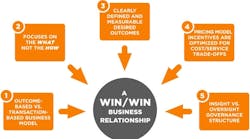Vested Outsourcing: Game-changing Rules for Outsourcing
Peter Drucker challenged companies to "Do what you do best and outsource the rest!".
Unfortunately, too many companies jumped into outsourcing using the same approaches and methods that they used for procuring commodities and materials to run their operations. The result is that far too many outsourcing deals are less than optimal -- leaving most in search of a better way to outsource.
The University of Tennessee studied some of the world's most successful outsourcing deals as part of a research project funded by the U.S. Air Force. Our work has uncovered the fact that successful outsourcing deals had one thing in common; they played by an unwritten set of rules that is fundamentally different than conventional approaches for procurement.
We have distilled our research into an approach that we call Vested Outsourcing -- because it is typified by an outsourcing relationship where both parties have a stake in maintaining the arrangement and work together to create a performance partnership that takes both the company outsourcing and the service provider to levels of cost, service and profitability levels not realized previously.
These are the Five Rules of Vested Outsourcing.
Rule #1: Focus on Outcomes, Not Transactions
Many conventional outsourcing arrangements are built around a transactional model. Most often this transaction-based model is coupled with a cost-plus or a competitively bid fixed-price-per-transaction pricing model to ensure the company buying the services is getting the lowest cost per transaction. The service provider is paid for every transaction -- whether it is needed or not. Thus, the more inefficient the entire process, the more money the service provider can make.
The company that has outsourced gets what it contracted, but perhaps not the best solution. Vested Outsourcing operates under a desired outcome-based model, with the emphasis on having the outsource provider align its interests to what the company really wants: an efficient and low-cost total support solution.A Vested Outsourcing business model fundamentally shifts how a company buys services in a performance-based approach. Instead of paying an outsource provider for unit transactions for various service activities, the company and its service provider agree on desired outcomes. Desired outcomes are still quantifiable but take a different form: they can be set availability, reliability, cost, revenue generation, employee or customer satisfaction, or even asset investment targets. In essence, Vested Outsourcing buys desired outcomes, not individual transactions. The service provider is paid based on its ability to achieve the mutually agreed desired outcomes.Rule #2: Focus on the WHAT, Not the HOW
Adopting a Vested Outsourcing business model does not change the nature of the work to be performed. At the operational level, there is still a need for parts to be molded/fabricated, assemblies to be performed, items to be packed, orders to be fulfilled, spares and repairs to be managed, etc. What does change is the way that the outsourcing company purchases the services.
Using Vested Outsourcing, the company outsourcing specifies what it wants and moves the responsibility of determining how it gets delivered to the outsource provider. According to the outsourcing paradox, firms outsource to a supplier because they know the supplier can do a better job, yet write the contract as if they are the experts. Good companies outsource for a reason: in-house operations are either too expensive, ineffective, or both. Why dictate in an area where you have decided you are deficient? It is up to the service providers to understand how to put the supporting processes together to achieve the desired outcomes.
Rule #3: Agree on Clearly Defined and Measurable Outcomes
The third hallmark of a good Vested Outsourcing partnership is clearly defined and measurable desired outcomes. All parties must be explicit in defining the outcomes they want. These outcomes are expressed in terms of a limited set-ideally, no more than five-high-level metrics. Organizations should spend the time, collaboratively, during the outsourcing process, and especially during contract negotiations, to establish explicit definitions for how relationship success will be measured. Investing time up front is critical to ensure that none of the companies spends time or resources after implementation measuring the wrong things.
Once the desired outcomes are agreed on and explicitly defined, the service provider can propose a solution that will deliver the required level of performance at a predetermined price. This approach fundamentally shifts the business model, shifting risk from the company that is outsourcing to the service provider(s). Under the purest form of Vested Outsourcing, the company that is outsourcing pays only for results, not transactions; rather than being paid for the activity performed, service providers are paid for the value delivered by their overall solution.
Rule #4: Optimize Pricing Model Incentives for Cost/Service Trade-offs
The fourth hallmark of a Vested Outsourcing partnership is a properly structured pricing model that incorporates incentives for the best cost and service trade-off. The pricing model is based on the type of contract- fixed price or cost reimbursement-that will be used to reward the outsource provider.
When establishing the pricing model, businesses should apply two principles:
- The pricing model must balance risk and reward for the organizations.
- The agreement should specify that the service provider will deliver solutions, not just activities.
The essence of Vested Outsourcing is a strategic bet by the outsource provider that it will meet the service levels at the agreed price. If the service provider does a good job, it will reap the rewards of greater profitability. Vested Outsourcing does not guarantee higher profits for service providers, but it does provide them with the authority and autonomy to make strategic investments in their processes and product reliability that can generate a greater return on investment than a conventional cost-plus or fixed-price-per-transaction contract might yield.
Rule #5: Governance Structure Should Provide Insight, Not Merely Oversight
In the early days of outsourcing, many companies made the mistake of simply throwing the work over the fence to the outsource provider, with poorly defined requirements and often no performance metrics or service level agreements. The downside is that many have gone to the other extreme. Today's outsource providers often have a small army of program managers who micromanage the outsource provider. An effective Vested Outsourcing partnership outsources to service providers that are real experts. Such partnerships should be managed to create a culture of insight, not oversight.
If a company has done a good job picking the proper outsource provider, a trusted expert in its field, why does it need a small army providing general supervision? A properly designed governance structure should establish good insight, not provide layers of supervisory oversight.
InVesting in Vested Outsourcing
For many, Vested Outsourcing will seem like heresy to tried and true outsourcing methods. For others, it will seem like a fresh approach to help companies achieve better success with outsourcing. Thought leaders from Microsoft, Intel and UPS are early advocates for the process. In fact, Microsoft has had such good success that they won the Shared Services Outsource Network "Best Mature Outsource Service Delivery" of the year award in April 2010. And leading practitioners like Brad Mitchell, President of Distribution and Logistics for UPS has proclaimed that "Companies will take a vested interest in Vested Outsourcing," projecting it will be one of the top 5 trends in Supply Chain.
Kate Vitasek is the lead researcher and faculty for the University of Tennessee's Center for Executive Education work in the area of outsourcing and performance-based approaches. She is also the Founder of Supply Chain Visions, a Top 10 supply chain management boutique consulting firm. Mike Ledyard is Program faculty at the University of Tennessee, and is also a co-founder of Supply Chain Visions.
Interested in information related to this topic? Subscribe to our weekly Value-chain eNewsletter.




